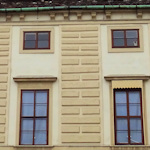
The Imperial apartments represent one part of the self-guided tour of the Sisi Museum and Hofburg interiors, sending you through around 20 rooms that offer intriguing clues to the character of their previous Habsburg occupants.
- Journey through apartments used by Emperor Franz Joseph and Empress Elisabeth in the late 1800s
- Puts you in the middle of some pretty impressive history
- Book a guided tour* of the Hofburg area
- See also:
- Sisi museum and Hofburg tour overview
- Empress Elisabeth in Vienna
Inside the Imperial apartments
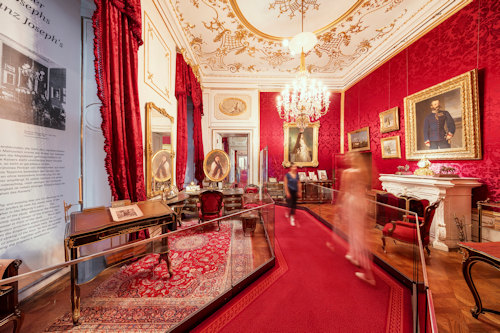
(Sisi Museum, Emperor Franz Joseph’s study; photo © Schloß Schönbrunn Kultur- und Betriebsges.m.b.H. Severin Wurnig)
The areas covered by the self-guided tour of the Sisi Museum and Hofburg represent just a tiny part of the entire complex, but include the apartments used by Empress Elisabeth and Emperor Franz Joseph.
The splendour, furniture and décor draw you back to the latter half of the 19th century. And the audio guide (included in a tour ticket) provides both the historical context and little bonuses, like an original recording of Franz Joseph ending an audience.
Franz Joseph’s apartments
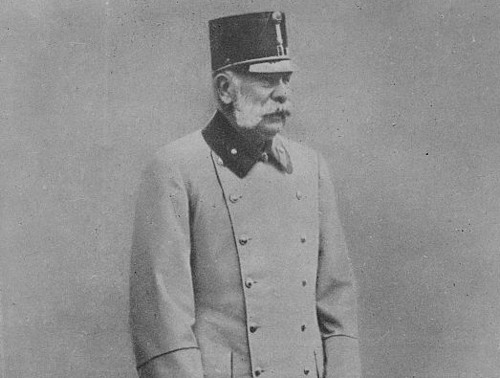
(Emperor Franz Joseph. Photo courtesy of the Library of Congress)
The tour begins in the rooms where the Emperor slept and worked, and takes you through, for example:
- Audience waiting room
- The audience chamber
- Conference room
- His study
- His bedroom
- Large salon
- Small salon
Almost immediately you begin to understand the work ethic and sense of responsibility that guided Franz Joseph throughout his life. And, if you paid attention in the Sisi Museum, you’re struck by the contrast to his wife, who you might feel fought for exactly the opposite.
The audience chamber offers a taste of the colours and styles to come, with the neo-rococo furnishings in gold and white, and the red silk damask upholstery and wall coverings.
Take note of the central 1832 painting by Johann Peter Krafft in the waiting room: it features the giant Burgtor gates you can see elsewhere in the Hofburg, but flanked by a fortified wall.
The study and bedroom, though, really bring Franz Joseph to life.
Nobody would describe the Emperor as the most progressive of monarchs, but two qualities shine through in the (relatively) functional bed, the (relatively) spartan dressing table, the early starts (he was up at 3.30am) and large portraits of Sisi that look down on his work space: a hard worker and a man in love.
Also, his pipe collection looks like something from the Lord of the Rings set.
Elisabeth’s apartments
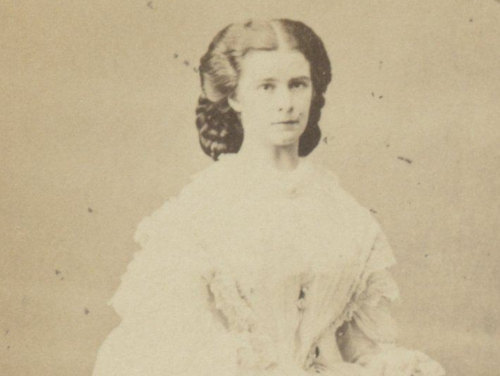
(Empress Elisabeth (“Sisi”). Image courtesy of the Rijksmuseum)
And then there’s Sisi.
Also a hard worker (on her riding skills, languages and appearance) and a woman in love (with travel and poetry, for example). The contrast to the rather steadfast and dutiful Franz Joseph is clear.
The second part of this tour section goes through or past various rooms used by the Empress. For example:
- Drawing room & bedroom
- Dressing room & exercise room
- Lavatory
- Bathroom (unexpectedly functional)
- The Bergl rooms (admire the landscape murals)
- Large salon
- Small salon
The Emperor would ring a bell to enter Elisabeth’s apartments and give her attendants time to get out of the way. I wondered if she dreaded that sound or welcomed it?
Luxurious historical fittings and furnishings fill many of the rooms. Apparently, the Imperial couple sometimes took breakfast in the large salon, but the décor is such that you’d be terrified of dropping strawberry jam anywhere.
The dressing room is, perhaps, the most poignant. It contains fitness equipment, like two rings hanging incongruously under a doorway: a hint at Sisi’s obsession with her figure.
Exercise equipment is not what you might expect in an Empress’s dressing room (not what the court expected, either). But then Elisabeth wasn’t like other Empresses.
I can’t figure her out, frankly.
Part of me admires Elisabeth’s rebellion against court protocol and traditions, and feels sorry for a dreamer who was uprooted from a happy home and more or less forced into the confines of Habsburg ceremony and expectation.
And part of me thinks Sisi was too self-indulgent and perhaps unnecessarily provocative.
I wonder, for example, how Franz Joseph felt about Elisabeth’s choice of photos; her Bavarian family back home and her favourite poet, Heinrich Heine, dominate…not the Emperor and her immediate family.
Did he care? Did she care?
Though perhaps the choice of photos might be a curatorial decision, rather than a faithful reproduction?
It’s all a little sad. All the wealth of an empire won’t help when your wife falls out of love with you (if she ever was truly in love with you). A romance that did not have the happiest of endings.
Other rooms
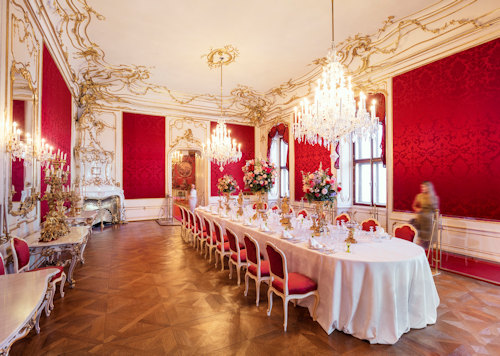
(Sisi Museum, dining room; photo © Schloß Schönbrunn Kultur- und Betriebsges.m.b.H. Severin Wurnig)
The tour of the apartments ends with a few extra rooms that remind you you’re walking through some serious history.
For example, pass through the Alexander apartments, where Tsar Alexander I of Russia stayed during the Congress of Vienna in 1814/1815.
And the Red Salon features furniture and Gobelin tapestries given to Emperor Joseph II by King Louis XVI of France in 1777.
At the conclusion, you’ll see the dining room decked out as if for a family dinner.
Each placing has six glasses, two decanters, two knives, three forks, and a spoon. And a napkin arranged using the legendary Imperial fold.
Apparently, dinners had between nine and 13 courses. So we can assume the meals consisted of more than just beans on toast and a carton of apple juice.
And that brings us to the shop and the end of the tour. But should you wish to see more of how the Habsburgs lived and “worked”, take the tour of Schönbrunn Palace.